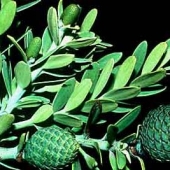Please select root levels for the menu
NZ Plants
Prumnopitys ferruginea - miro
Podocarp family: Podocarpaceae
-
Branch
L Jensen
View picture -
Stem, upper surface
L Jensen
View picture -
Leaf, upper surface detail
L Jensen
View picture -
Stem, lower surface
L Jensen
View picture -
Leaf, lower surface stomata
L Jensen
View picture -
Foliage comparison: mati (above) and miro (below)
I MacDonald
View picture -
Pollen cone
I MacDonald
View picture -
Ovule cone
L Jensen
View picture -
Ovule with basal micryopyle pore
L Jensen
View picture -
Enlargement of post-pollination ovule and green epimatium
L Jensen
View picture -
As the seed matures, the epimatium enlarges and becomes very fleshy.
L Jensen
View picture -
Mature seed covered by a red fleshy epimatium
J Braggins
View picture -
Removing part of the fleshy epimatium (left) reveals the seed (brown) to the inside
R Gardner
View picture
Prumnopitys ferruginea is a tall tree with a round crown and dark green slightly curved and pointed linear leaves that are flattened into two rows especially in juvenile stages. Small, fleshy cones are formed. Initially the ovule is covered by an integument and a thin epimatium (derived from the seed scale) but after fertilisation the epimatium develops into a fleshy tissue ensheathing the ovule to the inside. Formerly known as Podocarpus ferrugineus.
An endemic species found throughout the North and South Islands.
A small genus with two species endemic to New Zealand and eight additional species found in Australia, New Caledonia and South and Central America.
Vegetative characteristics |
Reproductive characteristics |
|---|---|
Adult plant form: tree up to 25 m |
Pollen and ovule cones: on separate trees |
Adult leaf form: narrow-linear, somewhat curved and taper to a dull point; not white on underside |
Pollen cone: solitary, 5-15 mm long, 30-40 scales, on short scaly stalk |
Adult leaf size: 15-25 x 2-3 mm |
Ovule cone: 10-15 mm long with 1-2 fertile scales, and several sterile spoon-shaped sterile bracts, on a stalk 8-10 mm long covered by overlapping green scales |
Adult leaf arrangement: singly on stem,arranged and spreading but twisted into two rows in one plane |
Ovule cone position: in axils of leaves |
Juvenile plant form: slender sapling, with drooping graceful stems but no interlaced branching |
Ovule coverings: an inner covering (integument) and an outer covering (epimatium) ensheathing the ovule |
Juvenile leaf form: flattened and spreading |
Ovule pore (micropyle): directed downward |
Juvenile leaf size: 20-30 mm long |
Mature seed cone: up to 20 mm long; a single seed with a hard woody seed coat (integument) enclosed in a fleshy red covering (epimatium |
Juvenile leaf arrangement: in two rows |
Stem(receptacle) below seed: not fleshy |




